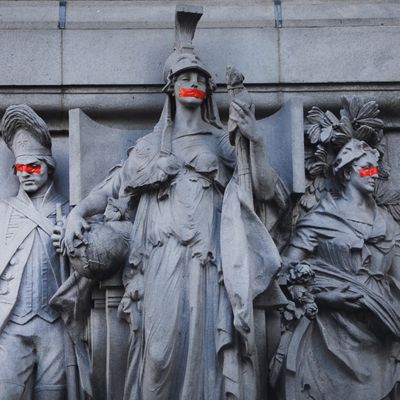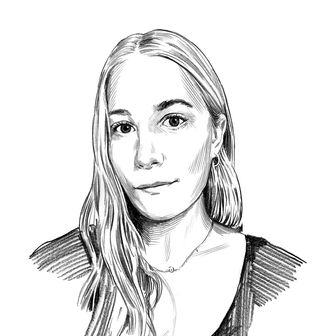
Outside New York’s City Hall on Friday, Jackie, 26, was handing out hand sanitizer, masks, and gloves to occupiers camped out in the small park there. A friend who works with Vocal-NY, the organization that had called for the City Hall occupation, to demand that $1 billion be cut from the NYPD’s budget, had told her about the protest, and she headed over, mostly armed with her free time. She had been working as a fabricator in Brooklyn before the pandemic but had been laid off — twice, once when shutdowns forced the business she was working for to close and again when the next place that hired her couldn’t afford to stay open. Now it was day three at the occupation. Jackie had no plans to go back to work, even with the city starting to open up, not to what she was doing before. “This feels much better,” she said.
Nationwide uprisings against police brutality have just passed their one-month mark and are showing no sign of abating. Instead, activists are digging their heels in, buoyed by mass support and by a wave of people left angry, disaffected, and jobless by the coronavirus — people who, like Jackie, have found purpose in protesting. In New York City, near-daily actions have counted participants in the tens of thousands since the first night of unrest on May 29 began at Brooklyn’s Barclays Center. Though the protests and marches have gotten smaller, their demands have crystallized and grown more urgent. For weeks, protesters around the country held signs and led chants calling to defund the police; on Tuesday, one week before City Council members would vote on the mayor’s budget, which originally allotted a staggering $6 billion to the NYPD, organizers camped out on their front lawn. Their intent was to make sure the council members physically couldn’t look away from the issue of police accountability. Thousands slept out, and thousands more joined a network of volunteers and donors, doling out supplies, finding bathrooms, conducting teach-ins, and making art.
Mark Shervington, a 55-year-old organizer with a campaign called RAPP (Releasing Aging People in Prison), was visiting the occupation for the first time on Friday. He had witnessed the city’s biggest moments of popular uprising in the last decade, Occupy Wall Street in 2011 and protests in response to the death of Eric Garner in 2014, on a television in prison. He was incarcerated in 1986, for “29 years, 10 months, and some days,” he recounted, originally sent away at age 20 for only 15 years but denied parole nine times. “It was as if time stopped,” he said. At first, when this year’s protests began, he was skeptical: “I thought, ‘Here we go again, we’re going to make some noise for a minute and then it’s going to be over.’ But this has continued.” Gesturing around the camping part of the encampment, where people lay on sleeping bags behind the busy stalls of food and supplies, he said that he was pleased to find “enough energy to take action, to be tactical.” As he handed out RAPP T-shirts to a few people playing cards on a blanket, Shervington said he “absolutely” believes he will see prison abolition in his lifetime.
On Monday, a day before the City Council was set to vote on the budget, it almost seemed as though the occupation, along with tens of thousands of phone calls and emails, had worked: Mayor Bill de Blasio announced that he and the City Council had agreed to cut $1 billion from the NYPD as part of the city’s austerity budget. (Millions had already been slashed, with more planned, from every other city department in the wake of the pandemic). But organizers and opponents immediately criticized the proposal, calling it a “fiction”: $459 million in purported “cuts” to funding for police officers in schools was actually being shifted to the already cash-strapped Department of Education, and the plan doesn’t include a full hiring freeze on new police officers. “We are not seeing a meaningful reduction in head count and the changes that people are literally marching in the streets for,” one council member told the New York Times. Hours later, in what protestors say felt like a show of force, the NYPD encircled the occupiers’ barricades at the City Hall encampment, then violently moved in, herding people to the sidewalk, shoving them with batons and arresting two men.
But even if activists don’t see the NYPD defunded in any meaningful sense this year, they sense a shift in possibility. A new Siena College poll of registered voters in New York found that 60 percent were in favor of June’s demonstrations, even though only 8 percent say they participated in them. The mood feels ripe to achieve radical transformation rather than incremental reform. Jumaane Williams, the city’s public advocate, said he would be invoking his authority to block the city’s budget from being executed if it does not include a true hiring freeze and “just transition away from the current school safety model.” “Progress cannot end on July 1st,” his statement read. “New Yorkers will not be content with low-hanging fruit, when what’s needed is to uproot the tree.”
Asked what the people living on the grass at City Hall are planning next, Jawanza James Williams, Vocal-NY’s director of organizing, wrote in a text from the occupation, “We must escalate.”



